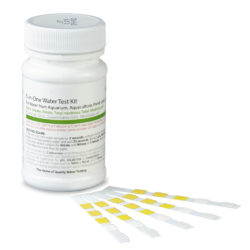When you discover a leak in your property it can be difficult to find out where the water is coming from. A simple and cost effective way is to test the water. Once you have decided what type of tests to carry out, check Process at the bottom of this article.
Option 1: Total Chlorine test
Treated water is likely to contain chlorine, which is added to the mains water for sanitary reasons. Therefore, a good test to use is the Total Chlorine test. Chlorine levels in drinking water should be between 0.2 and 2.0ppm. The World Health Organisation has set a health based guideline maximum value of 5ppm (mg/l) for chlorine as a residual disinfectant in drinking water. Total Chlorine measures the amount of free and combined chlorine in water.
A chlorine test works best when the leak contains fresh water because chlorine usually evaporates within 24 hours. If the water has been sitting for a while somewhere, then chlorine may have naturally disappeared and can not be detected anymore.
Option 2: pH test
Another option is to test the pH using wide range water pH test . The pH of water varies depending on its origin. Tap water should have a pH of 6.5 to 9.5. Rain water is usually more acidic, 4 to 5, due to its origin (primarily due to the presence of two strong acids, sulphuric acid (H2SO4) and nitric acid (HNO3)).
In cases where the water from the leak or flood travels through materials like earth, concrete or soil, it might pick up ions which will influence the pH – hence making it harder to determine the original pH and where the water has come from.
Option 3: Nitrate/Nitrite/Hardness/Alkalinity test
If the chlorine and pH tests are inconclusive then a 5in1* test for nitrates, nitrites, hardness and alkalinity might provide further information. The main causes for nitrates in water include agricultural activity, inorganic nitrogenous fertilisers and manures, erosion of natural deposits, leaking from sewer tanks or sewage. The maximum contaminant guideline for nitrate (as NO3) in tap water is 50mg/l and for nitrite (as NO2) is 0.50mg/l. Available as a pack with 25 tests or 5 tests.
(*please note, that the pH range in this particular test does not cover the acidic range and hence might not show acidic rain water. In this case the wide range pH test is recommended.)
Laboratory tests are often used when it is more tricky to establish the source of a leak or when a laboratory result is required as part of evidence:
Option 4: Water Suite 8-in-1 laboratory test
This laboratory chemistry test checks the levels of pH, total hardness, total dissolved solids (TDS), conductivity, calcium hardness, M. alkalinity, total chlorine and chloride. Analyse 2 or more water samples to establish if they are from the same source or not. Take a water sample from the leak as well as surrounding water sources (ie ground water, tap water etc) so the results can be compared to each other. This lab test is recommended where the water from the leak is fresh and it has not travelled through other materials like soil, concrete or earth.
Option 5: Water Suite 9-in-1 laboratory test
The laboratory chemistry test checks the levels of pH, Alkalinity, Chloride, Fluoride, Conductivity, Total Hardness, Nitrite, Nitrate and Ammonium (as NH4). Take a water sample from the leak as well as surrounding water sources (ie ground water, tap water etc) so the results can be compared to each other. This laboratory test is recommended where there is a suspicion that the cause of the leak is likely to be effluent or sewage water.
Option 6: Test for faecal contamination (bacteria test)
If you suspect that the leak might be from a sewage pipe, then you can test for the presence of faecal bacteria:
- Option 1: Home test for coliform bacteria Easy Coliform bacteria (2 tests) is ideal.
- Option 2: Laboratory test for Coliform/ E.coli & Intestinal Streptococci
–> Customer feedback shows that the tests in option 1 & 2 are often effective in establishing the source of a leak. The laboratory tests are recommended when the other tests have been inconclusive or laboratory analysis is required to support the findings.
Process: To use test strips to identify the source of a leak, it is best to test water from different sources around the property, note the result for each and then compare the results to the water in the leak:
- Test your tap water,
- Test your rainwater (collect some or use water from a water butt or bird table in the garden),
- Test groundwater, potential streams, wells and other potential sources of the leak,
- Test the water in the leak and
- Compare all results to find a match.
Please note, that whilst it helps to test the water of the leak and the various water sources around a property, water testing may not be entirely conclusive. This will be the case when chlorine has evaporated from the water in the leak or the pH levels are too similar to make a clear distinction. A number of different tests may be necessary to eliminate potential sources of the leak.
Good luck with identifying the source of the leak!
Total Chlorine Test:
Contains: 50 strips
Testing Levels: Method A: 0, 0.1, 0.2, 0.5, 0.8, 4.0, 10.0 ppm (mg/l), Method B: 0, 0.05, 0.1, 0.15, 0.2, 0.5, 1.0 ppm (mg/l)
Total Test time: 33 seconds
Wide Range Water pH Test:
These wide range pH test strips are the convenient measurement tool for pH. It covers nearly the whole pH range from 2 to 12, whilst still measuring smaller increments in the crucial range of 6 to 10, therefore providing accurate results.
Contains: 50 strips per bottle
Testing Levels: pH: 2, 3, 4, 5, 6, 6.5, 7, 7.5, 8, 8.5, 9, 9.5, 10, 11, 12
Total Test time: 30 seconds

Water Test Kit (5-in-1) Aquaculture/Well (25 strips):
Contains: 25 strips
Testing Levels:
- pH: 5.5, 6.5, 7.0, 7.5, 8.0, 8.5, 9.5
- Total Alkalinity: 0, 40, 80, 120, 180, 300, 720 ppm (mg/l)
- Total Hardness: 0, 25, 75, 150, 300, 1,000 ppm (mg/l)
- Nitrite: 0, 0.5, 1, 3, 5, 10, 20 ppm (mg/l)
- Nitrate: 0, 20, 40, 80, 160, 200 ppm (mg/l)
Total Test time: 1 minute 30 seconds

Water Suite 8-in-1 (Laboratory Test)
This laboratory test will check the levels of each of 7 elements in your water sample: pH, Total Hardness, Total Dissolved Solids (TDS), Calcium Hardness, Conductivity, M. Alkalinity, Total Chlorine and Chloride. This kit has been designed to help establish if water samples are from the same source (e.g. for leak detection) and is also useful to establish the scaling and corrosive tendencies/properties of water.
For leak detection: a minimum of 2 samples is needed for a comparison analysis.
Suitable for: Potable water analysis as well as fresh water samples, including water from tanks, taps, wells, springs, boreholes, ponds, as well as rain water.
Further Free Resources:
Got a question about water testing? Try our complete list of Free Water Testing Resources. Here are the most frequently read guides:
- Click here to download our FREE Water Guide
- Read an overview of the potential contaminants in your water
- Why test your water and water supply?
- Unusual colours, smells and taste of your water & further advice on finding the right test kit
- How to choose the right Water Testing Kit
- Choosing the right water testing kit for a water improvement & purification system, water cooler or a pool, spa or hot tub
- How to understand the results of your Quality Water Test Kit
- How to test for lead correctly and what immediate steps can be taken to reduce lead exposure
- How to get the best drinking water – which water filter?
- How to check if my water filter is working?
- How to test the pH of soap?
- How to look after your hot tub safely and test the water regularly
- What is best pH level for drinking water? How to measure the pH of water & other liquids correctly
- How to test the quality of Open Water for bathing or swimming
- Commercial Applications for Water Testing: Buyers Guide – Water Testing on vessels, ships as well as water tanks in remote locations
If you can’t find what you are looking for then please contact us, as we can source many other test kits. Discounts for bulk purchase available, please contact us to find out more.
Disclaimer: Only opinions based upon our own personal experience or information detailed in academic journals or other publications is cited. This has been done exclusively for anyone who is interested in this subject but is not intended to replace proper analysis. We cannot accept responsibility and liability of any kind which may result from the application of this information. We always recommend to consult an expert to discuss any test results or get a full recommendation on the specific subject and specific to your situation by an expert.
This information is owned by SimplexHealth and you do NOT have the right to reprint, sell, auction or distribute this information.


